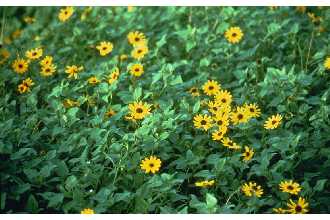Cucumberleaf Sunflower
Scientific Name: Helianthus debilis Nutt. ssp. debilis

| General Information | |
|---|---|
| Usda Symbol | HEDED |
| Group | Dicot |
| Life Cycle | AnnualPerennial, |
| Growth Habits | Forb/herb |
| Native Locations | HEDED |
Plant Guide
Use soil moisture sensors to measure the soil moisture of Cucumberleaf Sunflower.
Fact Sheet
Alternate Names
beach sunflower
Uses
Cucumberleaf sunflower is used for stabilizing the backdune area of coastal sand dunes, providing wind erosion protection, and beautifying beaches. Its seed provides food for wildlife. The plant acts as a perennial in southern Florida and as a reseeding annual throughout central Florida.
Status
Please consult the PLANTS Web site and your State Department of Natural Resources for this plant’s current status (e.g. threatened or endangered species, state noxious status, and wetland indicator values).
Description
Cucumberleaf sunflower is a low-growing herbaceous perennial. Leaves alternate along the stem and are deep green on both upper and lower surfaces. Leaves are broad, wedge-like to heart-shape, and approximately 2 to 3 inches long. Flowers are a daisy-like composite, bright yellow, and about 2¾ inches across; they can appear from March through November. The plant is broadly branched along the short stems. Many branches are decumbent or horizontal. The plant spreads readily by above ground stolon-like runners.
Adaptation
While the species Helianthus debilis has a range from South Carolina to coastal Texas, the subspecies debilis is native to Florida. It is adapted to well-drained, droughty, nutrient poor soils, such as those found on beaches, as well as on some disturbed sites, parks, and solid waste reclamation sites. For a current distribution map, please consult the Plant Profile page for this species on the PLANTS Website.
Establishment
It is best to work with vegetatively propagated plants. Although plants can be started from seed, there is no guarantee that the resulting plants will be true to type, since the various subspecies of Helianthus debilis can cross-pollinate. Generally no site preparation is required, and planting can be done December 1 through February 1 in southern Florida, March 1 through April 15 in northern Florida, or June 1 to August 1 during the rainy season throughout Florida. Brooksville Plant Materials Center Brooksville, Florida Plant rootmass of transplants ½ to 1 inch below the prevailing soil surface in rows on a 12- to 30-inch spacing. Offset plants in rows to deter wind erosion. Place 1/3 ounce of 14-14-14 slow release fertilizer in the hole with each plant or broadcast 100 to 150 lb of 10-5-10 fertilizer per acre 2 to 3 weeks after planting. Adequate water is necessary for up to 6 months, to insure survival of the planting. The plant should dictate by visible stress signs when water is needed.
Management
Broadcast 10-5-10 or equivalent at the rate of 150 to 200 lb per acre annually in mid-summer, Use soil moisture sensors to measure the soil moisture of Cucumberleaf Sunflower.,
